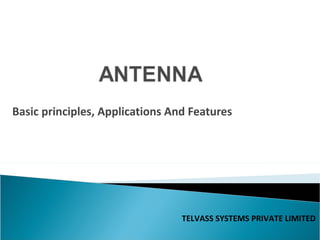
Telvass Systems Pvt Ltd Antenna Ppt
- 1. Basic principles, Applications And Features TELVASS SYSTEMS PRIVATE LIMITED
- 2. DEFINITION A metallic apparatus for sending and receiving electromagnetic waves. Usually it is a metallic device (rod or wire) for radiating or receiving radio waves. An antenna is a transitional structure between free-space and a guiding structure.
- 4. BASIC ANTENNA PARAMETERS Radiation Resistance RA: The equivalent resistance which would dissipate the same amount of power as the antenna radiates. Input impedance ZA : The ratio of the voltage to the current at the antenna terminals. Polarization: The direction of the E-field.
- 5. BASIC ANTENNA PARAMETERS Radiation pattern: The relative distribution of radiated power as a function of direction in space – an (hypothetical) isotropic antenna radiates equally in all directions. Gain G : The ratio of the radiated power in the maximum direction to the radiated power of an isotropic antenna. The gain of an antenna represents the ability to focus its beam in a particular direction – an isotropic antenna has a gain of 0 dB.
- 6. BASIC ANTENNA PARAMETERS Beam width: The angle between the two directions in which the radiated power is half of the maximum value of the beam. Bandwidth: Half-power frequency band. Antenna efficiency: e = Prad / Pin Effective aperture: It describes the effectiveness of an antenna in the receiving mode. It is defined as the ratio of the power delivered to the load to the incident power density.
- 7. RF CONNECTORS TYPES OF CONNECTOR 1) STANDERD TYPES: N Connector [Neill] Designed : 1940 Designer : Paul Neill Pass Band : 0-18 GHz BNC Connector [Bayonet Neill Concelman] Designed : 1951 Designer : Paul Neill, Pass Band : 0-3 GHz
- 8. RF CONNECTORS 1) STANDERD TYPES: 7/16 DIN Connector: Designed : Designer : Spinner Pass Band : 0-18 GHz C Connector [Carl Concelman] Designed : Designer : Carl Concelman] Pass Band : 0-11 GHz
- 9. RF CONNECTORS 1) STANDERD TYPES: F Connector : Designed : 1950 Designer : Eric E. Winston Pass Band : 0-1 GHz GR Connector: Designed : 1960 Designer : General Radio Corporation Pass Band :
- 10. RF CONNECTORS 1) STANDERD TYPES: TNC Connector [Threaded Neil Concelman] Designed : 1950 Designer : Paul Neill & Concelman Pass Band : 0-11 GHz UHF Connector: Designed : 1930 Designer :E.Clark Quackenbush Pass Band : 0-300 MHz
- 11. RF CONNECTORS 2) MINIATURE TYPES: MMCX Connector [Micro Miniature Coaxial] Designed : 1990 Designer : Pass Band : 0-6 GHz MCX Connector: Designed : 1980 Designer : Pass Band : 0-6 GHz
- 12. RF CONNECTORS 2) MINIATURE TYPES: UFL Connector : Designed : 1990 Designer : Pass Band : 0-6 GHz IPX Connector: Designed : 1990 Designer : Pass Band : 0-6 GHz
- 13. RF CONNECTORS 2) MINIATURE TYPES: SMA Connector[Sub Miniature Version A] Designed : 1960 Designer : Pass Band : 0-26 GHz SMB Connector[Sub Miniature Version B] Designed : 1960 Designer : Pass Band : 0-4 GHz
- 14. TEST SETUP FOR ANTENNA MEASUREMENT VNA TX’r RX’r PORT 1 PORT 2 D D= Distance Between Antenna In KM TX’r= Transmitting Antenna RX’r= Receiving Antenna VNA= Vector Network Analyzer
- 15. FORMULAS REQUIRED FOR ANTENNA EVALUATION Free Space Loss(FSL)=92.5+20 log(Freq in GHz)+20 log(D in KM) Total Loss(TL)= FSL + Measured Cable Loss Gain(G)= (TL - RSL)/2 If both TX’r and RX’r are same. Gain(G)= TL-RSL-Gr Front to Back Ratio(FBR)=RSL@0° - RSL@180° RSL= Received Signal Level Gr= Gain of Reference antenna
- 16. Parabolic Dish Antenna : A parabolic antenna is an antenna that uses a parabolic reflector, a surface with the cross-sectional shape of a parabola, to direct the radio waves. Sector Antenna : A sector antenna is a type of directional microwave antenna with a sector-shaped radiation pattern. Omni Antenna : An Omni directional antenna is an antenna which radiates power uniformly in all directions in one plane, with the radiated power decreasing with elevation angle above or below the plane, dropping to zero on the antenna's axis.
- 17. Patch Panel Antenna : A patch antenna is a type of radio antenna with a low profile, which can be mounted on a flat surface. Yagi Antenna : A Yagi-Uda array, commonly known simply as a Yagi antenna, is a directional antenna consisting of a driven element and additional parasitic element. Grid Antenna : A Grid antenna is a directional antenna similar to parabolic dish antenna with narrow beam width.
- 18. Parabolic Dish Antenna: Microwave Relay links that carry Telephone and Television Signals Wireless WAN/LAN links for data communication Satellite and Spacecraft communication antenna Sector Antenna: Antennas for cell phone base station sites Used for limited range distance of around 4 to 5 Km. WiFi Application
- 19. Patch Panel Antenna : WiFi/WiMAX LAN Omni Antenna: Radio broadcasting Mobile Devices that use radio such as Cell Phones, FM Radios, Cordless Phones… etc Grid Antenna : WiFi/ WiMAX LAN Video and Audio Transmission
- 20. Yagi Antenna : Television broadcast bands Traditional Radios Grid Antenna : WiFi/ WiMAX LAN Video and Audio Transmission
- 21. Wireless systems becoming an important infrastructure in our society. A virtual global system is a good solution that can efficiently connect many dedicated wireless systems including 2G to 4G cellular systems, wireless LAN, broadcasting systems, etc.
- 23. THANK YOU